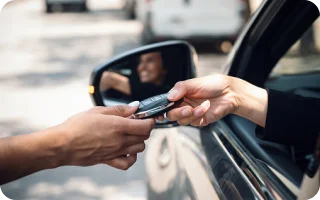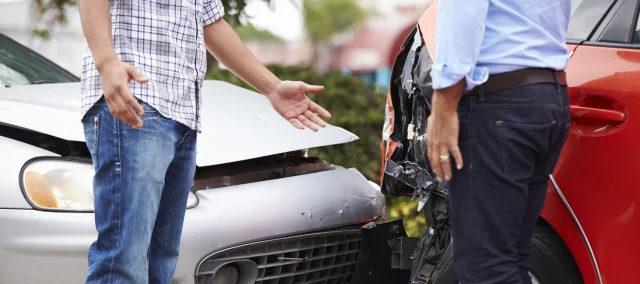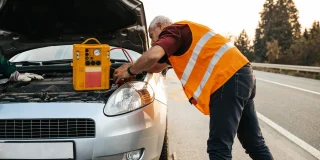Car Insurance Quotes
Get Cheap Car Coverage Near Me
Get Low-Cost Auto Insurance Rates to Fit Your Budget
Most drivers feel they pay too much for their insurance coverage, whether that’s home, car or some other type. It may feel like you are paying a large part of your income every month for something you are not even sure you really need or can afford. When it comes to your automobile policy, the truth is you really cannot afford to go without it, since the consequences of driving uninsured may prove highly expensive, whether that’s through tangling with the law in your state or by being at fault in a crash.
Many people feel they drive too safely to ever be involved in or cause a crash. The fact is, you could easily hydroplane into someone else on a rainy day. Or be momentarily distracted by something and rear-end the driver in front. It happens. Since every state requires some form of auto coverage (or the ability to pay for any damages you cause out of pocket), finding cheap car insurance that still protects you and your finances is the goal.

That’s where Acceptance comes in. Our local agents are pros at making sure you at least meet your state’s minimum requirements within your budget. If you need or want additional protection, we can do that, too.
What Is Car Insurance?
Car insurance protects your finances if you are involved in a covered event, such as a collision. A policy is a contract between you and an insurance carrier. You pay a provider an agreed-upon amount on a regular basis and, in return, you have financial coverage when an emergency happens. With insurance, you pay your provider so you can drive with peace of mind and know that your vehicle will be covered in the event of an accident.
All states require minimum liability coverage or the ability to prove you can pay for injuries and damages out of pocket. If your vehicle is leased or financed, you will be required to carry full coverage auto coverage. Full coverage consists of liability, plus comprehensive and collision. Keep reading to learn more about these types of auto insurance.
How Do Auto Insurance Quotes Work?
Once signed, your auto insurance quote is a contract between you and your carrier. This document spells out how the insurer will provide financial coverage if you are involved in a covered event, as outlined in your policy. Read your policy carefully and ask your friendly neighborhood agent to explain anything you do not understand.
You should make sure you are clear about how much your premiums will be, how often they are due (every six months, month-to-month or for some other agreed upon time), what is excluded and how much your insurer will payout in the event of an approved claim.
Some forms of coverage include a deductible. Keep reading to learn more about how deductibles work and how you can use your deductible to increase or decrease your premium, as well as answer some common questions about auto insurance.

How to Read Insurance Coverage Requirements
When you purchase your policy, you’ll be asked how much you want to have as minimum coverage. On your policy, this will be represented as a string of 2 or 3 numbers, such as 100/300/50. This is the maximum amount your insurer will pay out in the event of an approved claim. These numbers represent:
- $100,000 maximum for bodily injury/death you cause one person in one accident.
- $300,000 maximum for bodily injury/death you cause two or more people in one accident.
- $50,000 maximum in property damage per accident.
As long as you have at least the state-required minimum, you can increase these amounts as much as you want to feel protected.
What are the Different Types of Car Insurance?
Depending on what kind of vehicle you drive, including whether it’s financed or leased, you may choose from six different main types of auto coverage, including liability, collision, comprehensive, personal injury protection (PIP), uninsured motorist coverage and medical payments (MedPay). Every state has different requirements for its drivers, and your lender will require full coverage (liability, plus comprehensive and collision).
- Liability Insurance: If you are at fault in a car accident, this policy will help cover the car repairs and medical expenses of the other driver up to your policy limits.
- Collision Coverage: This policy helps cover repairs or pay the actual cash value of your vehicle if totaled after a covered event, such as a car wreck.
- Comprehensive Coverage: This coverage helps pay for repairs or ACV and is usually applied to events that happen when you are not behind the wheel, such as theft or hailstorms.
- Personal Injury Protection (PIP): Supplemental medical coverage to help pay for expenses related to any injuries you or your passengers suffer in a covered event.
- Medical Payment Insurance (MedPay): Supplemental medical coverage to help pay for expenses related to any injuries you or your passengers suffer in a covered event.
- Uninsured Motorist Coverage: This helps pay for injuries and damages you suffer after a wreck caused by an uninsured or underinsured motorist, or a hit-and-run driver.
Types of Auto Insurance Coverage
Choose From Different Optional Car Coverage Types
In addition to the 6 main types, most carriers offer other optional coverages suitable for different circumstances. For example, if you have a brand-new car, you may elect to have Gap for the first couple of years.
- Gap Insurance: If your new vehicle is stolen or totaled, this protection kicks in to pay the difference between the Actual Cash Value of your vehicle and what you still owe your lender.
- Rental Car Reimbursement: This kicks in to offer additional funds to reimburse you after you rent a car when yours is in the shop for repairs after a covered event.
- SR-22: This insurance is for high-risk drivers. You may be required to carry this type of insurance after a serious offense, such as DUI.
- New Car Replacement: This policy will replace your vehicle with one of the same make and model (or equivalent) after a covered event, such as a total loss resulting from a wreck.
- Non-Owner Car Insurance: If you do not own a car but frequently borrow or rent one, you can buy this insurance that will keep you protected at a discounted price.
- Classic Car Insurance: Specifically for vehicles of a certain age or style. This covers you when you are driving your classic in a parade or parked at a car show.
What are Average Rates for Auto Coverage?
Across the U.S., drivers pay an average of $2,014 for full coverage and $622 for the minimum required liability. Of course, your rates will depend on many factors, including where you live, how old you are and more. No two drivers will have the same premium.
When searching for an affordable policy offering the protection you need, understanding what others in your area pay will help guide your decisions. The average cost of insurance varies wildly from state to state and depends on many unique bits of information insurers use to determine the risk of offering you a policy. Reach out to your neighborhood independent Acceptance agent to find a policy that offers excellent protection that you can afford.
Ready to Get a Quick Quote?
Shop and Compare Auto Insurance Rates to Save
Most people feel they spend too much on car insurance. But there are some ways you can save on your policy, including shopping around to compare car insurance quotes from different providers. The state you live in sets the base rate insurance agencies can charge, but after that it is each carrier’s decision how much to charge you for your policy. Shopping around and comparing prices can be done anytime, especially if you are a month-to-month customer. If your policy suddenly jumps up in price, start comparing.
Or better yet, let us do it for you. At Acceptance, professional, bilingual agents are happy to do the research for you and present you with a variety of options, so you get the coverage you need at a price you can afford.
What Causes High Car Insurance Rates?
Many factors determine your rates and underwriters spend their time factoring all those into algorithms to come up with a quote. Every six months or so, when your policy comes up for renewal, your carrier will review your factors to see if anything has changed, which could cause an increase or a decrease.
For example, if you’ve made a claim in the preceding months, your rates may go up. If you’ve turned 23 and you’ve kept a clean driving record, your rates could go down. Here are some other reasons rates could go up:
- You’ve moved into an area where car crime is higher, or there is more congestion and accidents.
- You’ve purchased a new vehicle that is a known target for thieves, such as some pickup trucks and sporty vehicles.
- You’ve been convicted of DUI – this may cause you to receive a high-risk driver designation or file an SR-22 form with your state. Finding affordable DUI insurance can be challenging, but we can help with that.

What Can Help to Get Lower Car Insurance Rates?
Getting a lower premium is the goal. One way is to shop around and compare — or even switch carriers. You can also make use of car insurance discounts, such as bundling your home and auto policies together. Some other steps you can take to help lower your premium include:
- Choose a vehicle that has a high safety rating, green features or the latest in anti-theft technology.
- Raising your deductible will cause your premium to go down.
- Make sure you maintain a safe driving record with no blemishes.

Using Car Insurance Discounts to Save Money
A tried and true method for lowering your premium is using car insurance discounts. Every insurer offers them, so you want to find the company that offers the best discounts that apply to your situation. For example, one of the biggest discounts is for driving safely. If you’ve managed to drive for several years with no accidents or tickets, you may qualify for a Safe Driver break of up to 25% off.
Another profitable one is called bundling. When you trust the same insurer to cover two or more insurables, you can save quite a bit. For instance, you can save up to 25% off by bundling your car and home insurance together. Here are some more popular discounts:
Do I Need Auto Insurance?
Yes. Everyone who drives needs it. Besides the fact that your state laws require you to carry protection, you may stand to lose quite a bit financially if you choose to drive without coverage. How much you carry depends on you, unless your vehicle is financed or leased, in which case your lender or the car’s owner will dictate your levels.
Keep in mind that purchasing the minimum required levels of liability will not offer much protection if you cause an accident. For example, car insurance in California only requires $5,000 of property damage liability. If you hydroplane into someone’s brand new vehicle on a rainy day, you’ll be looking at more than $5,000 in damages. Everything over that amount comes from your own pocket.
What else is out of pocket? All of your own injuries and damages. Your liability does not cover you. This is why it is advised to carefully consider how much liability you need to have, as well as whether or not more protection in the form of collision coverage or comprehensive coverage is appropriate.
Additionally, it’s a sad fact that many more people than you think are driving around with no protection — or not enough. If they crash into you, you may not have the money to fix your damages and pay for your injuries. That’s why uninsured motorist coverage is always recommended. It only averages around $50-$75 per year, so it’s a great deal for the level of protection it offers.

How Can I Find the Best Car Insurance for Me?
You do not have to get confused when searching for the best car insurance for your specific circumstances. Although there are many options out there, finding cheap auto protection that meets your needs and your budget does not need to be overwhelming. We have experience in helping even drivers with less than perfect records find budget-friendly coverage. Even first-time drivers can find an affordable policy.
Comparing rates is the best way to find a plan that meets your needs. At Acceptance, our agents know you have better things to do than spend your time comparing rates across numerous carriers. That’s why we do the research for you. We’ll listen to what you want and how much you can afford, then present you with multiple options so you can pick the one you like.
All Products We Offer
Our agents work with top national insurance companies. Choices galore!
How Much Vehicle Insurance Do I Need?
You want to get enough to satisfy your state requirements, plus make you feel safe when driving. It’s a balancing act between how much risk you are willing to assume and how much will make you feel protected. In some cases, you may feel more comfortable taking on more risk and buying as little as possible. Depending on where you live and what kind of traffic and weather you encounter, you may want more.
Luckily, you do not have to figure this out on your own. Your neighborhood Acceptance agent will help you weigh the risks and protection, so you have a policy that covers your needs without breaking the bank.
Get Affordable Car Coverage Today
At Acceptance Insurance, our agents, are here to help you find customized and affordable car insurance you need to stay safe on the road. Please reach out for a free auto coverage quote online anytime, give us a call at 877-405-7102 or stop by one of our convenient locations for a face-to-face chat. We look forward to speaking with you.




